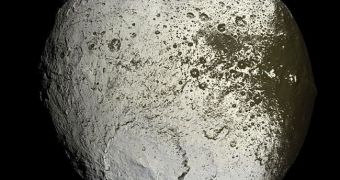In a new scientific investigation, astronomers were finally able to get more insight into the phenomena and processes that lead to the Saturnine moon Iapetus taking on the odd yin-yang look that it does. Apparently, what it all comes down to is the presence of dust in the orbit the moon takes.
Iapetus' external appearance puzzled experts since the moon was first discovered. Physicists know that the object is covered with a thick layer of ice, and that it may be made of the stuff entirely. However, that does not explain why one of its faces is black as coal.
At the same time, the other one is bright and white, reflecting a large proportion of the sunlight hitting it. Scientists now believe they have a deep understanding of the chain of events that lead to this body being colored in this unusual pattern.
They say that primarily responsible for this is another of Saturn's moon, which ejects dust into Iapetus' orbit. Another important factor in this interaction is that the moon itself does not rotate around its axis, which means that it will always keep the same face oriented towards its direction of motion.
In this regard, the object resembles Earth's Moon. Tidal interactions between the latter two are so intense that the Moon cannot spin around its axis, and constantly keeps the same face oriented towards Earth. Experts refer to the two bodies as being tidally locked.
“Iapetus is probably one of the most striking bodies in the solar system, and one of the longest-standing problems in planetary science,” Cornell University expert and study team leader Daniel Tamayo says.
The dark, distant and irregularly-shaped moon Phoebe is responsible for ejecting dust in Iapetus' path, the investigator explains. Details of his new work appear in the July 7 issue of the esteemed scientific journal Icarus, Science News reports.
One of the most interesting aspects of Phoebe is that it has a retrograde orbit around the gas giant, which means that it travels backwards in orbit, with regards to the planet and other moons. “If you’re driving on the highway, you’ll have more collisions if you’re going against traffic,” adds Joseph Burns.
The expert is a coauthor on the new study, and also Daniel Tamayo's adviser. He explains that Ipaetus is basically flying thorough a storm of dust, that splatter against its surface like bugs on a windshield.
The Saturnine moons Titan and Hyperion are also affected by this dust. Admittedly, they only receive the dust that gets past Iapetus, which isn't much. Experts arrived at the new conclusions after analyzing mathematical models of the interactions taking place in Jupiter's orbit.
“This is a very significant paper. It does the math,” comments astronomer Bonnie Buratti, who is based at the NASA Jet Propulsion Laboratory (JPL), in Pasadena, California.

 14 DAY TRIAL //
14 DAY TRIAL //